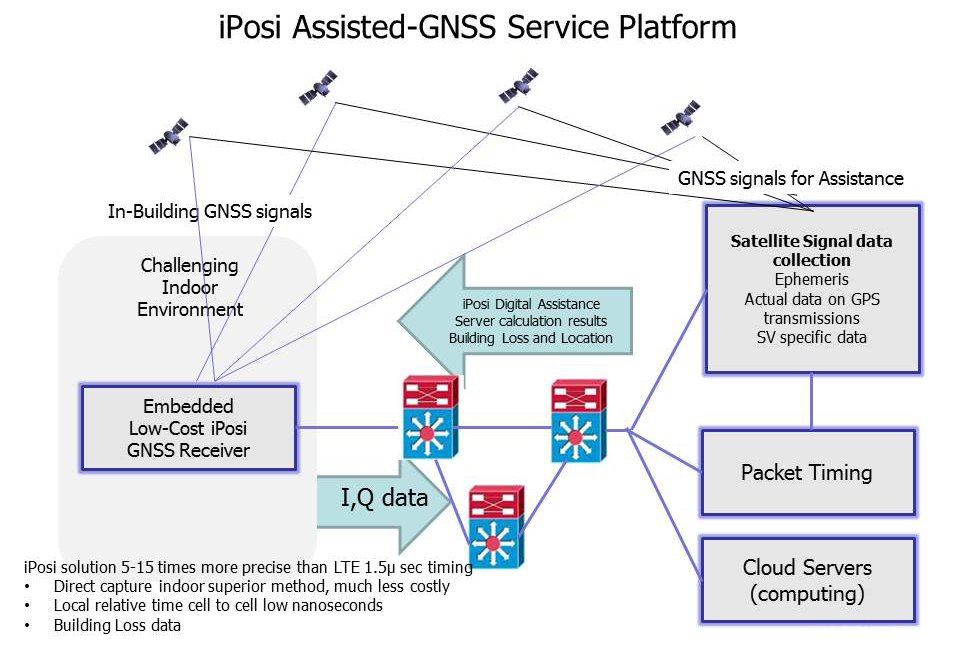High Definition (HD) Correlation Benefits
Matching the incoming satellite signal characteristics including “fine” time and frequency synchronization enables each iPosi receiver to use baseband signal processing resources extremely efficiently. This also achieves extraordinary performance in several key dimensions: overcomes signal attenuation and blockage, overcoming high signal non-uniformity (“near-far” impacts) where stronger signals mask weaker ones, overcoming extraneous signals such as jamming or co-channel satellite signals intended to share the same frequency bands, and overcoming excess path distortions caused by multipath or diffraction.
The primary advantage is that the receiver sensitivity is greatly improved, and reaches a -175dBm threshold. Thus signals can be reduced by 100,000 outdoor levels but still be detected using the iPosi iP-GPS solution. iPosi receivers exceed by nearly 40dB (10,000 times) the threshold sensitivity of unassisted GPS receivers. Mobile GPS uses an assisted GPS method to achieve greater sensitivity than un-assisted GPS, but it’s limited due to network, movement, oscillator shifts, and battery power consumption. Mobile assisted GPS is about 25 dB (300 times) less sensitive.
A subtlety is that GNSS can be limited by self-interference between its own satellites due to satellite-to-satellite spread spectrum code interference. The spread spectrum codes, used by GPS for example, provide inherent rejection of about 20dB and so can work with one satellite signal about 100 times greater than another. This might occur if a GPS receiver is under a tree and one satellite is shaded by the tree or a building wall and another has an open sky. If the signal difference is greater than 20dB the GPS receiver will fail. The iPosi GNSS receiver provides additional rejection of 22dB and can work in this environment as well as in buildings with a strong signal coming from a window and another coming through a wall, as happens inside buildings.
GNSS signals that are available in suburban, urban and inside buildings can arrive along many paths other than directly from the satellite. This is because they reflect off the surfaces of other buildings and structures along with a direct path in clear line of sight to the satellite or after some attenuation of that direct signal. The reflected signals, and also diffracted signals which propagate by bending around the edges of physical structures such as buildings thus increases the apparent time of arrival relative to a direct ray path. When viewed by the receiver these form a complex multi-ray signal having different arrival times which makes path measurements variable or shifted by some value resulting in an error. These signals also have their frequencies slightly altered as well. The iPosi HD Correlation property in its receivers can detect these small frequency differences to limit path distortions which have been difficult or impossible in previous generation receivers.
Time Spread Observation and Joint Signal Processing
iPosi’s software engine consists of several levels of GPS/GNSS signal processing to achieve optimum indoor performance. iPosi reduces errors in several dimensions by continuously processing signals as satellite positions and geometries change as they circle the sky above. Typical mobile GNSS receivers provide “snapshots” but cannot exploit longer term signal images effectively due to their limited time and scope of processing and receiver motion when inside. While mobile devices have excellent performance in clear outdoor visibility, tracking signals indoors is much more challenging. iPosi selects signals continuously received over time then uses its network servers where “in-cloud” algorithms reside to improve measurements intelligently to enhance location accuracy and time transfer precision.
Indoor GPS signals fluctuate; they often change in amplitude by several orders of magnitude. Mobile receivers have a limited window of signal change due to limited processing time. iPosi takes advantage of processing signal sets and compares these over time. Thus it can tolerate high fluctuations or outages which mobile GPS cannot and require satellites to remain visible when producing a snapshot fix solution. Thus, iPosi can observe satellite signals over a tolerable “time spread observation” period, collecting measurements to be jointly processed alongside others. This is extremely powerful since it allows satellites to come into view even below threshold -175dBm levels. This additional gain provides an additional dimension of sensitivity over conventional threshold receiver sensitivity.
Low Cost Hosted Implementation
iPosi software GNSS and reference design utilizes existing CPU and network interface resources to minimize cost. iPosi operates in the background though at time of installation uses the resources carefully to provide rapid initial position and sync. Once acquiring these references the iPosi receiver moves to background activity levels. Network synchronization bandwidth is also kept at a low state to reduce network overhead and capacity constraints.


